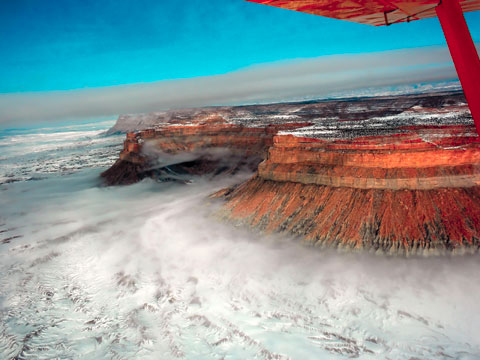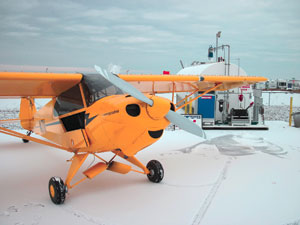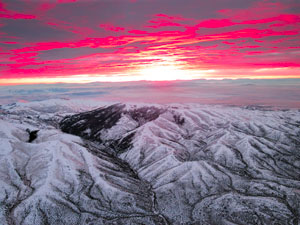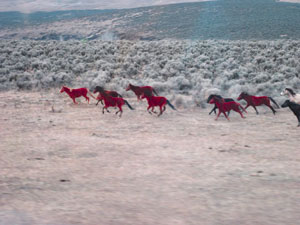Cross-country in a Cub
Lessons learned over a 3,000-mile trek

Noting the minus-20 degrees Fahrenheit temperature outside and the jagged peaks all around, I asked myself—not for the first time on this journey— What is a flatlander from South Florida doing in the middle of winter flying a light sport Cub through the Rocky Mountains? I found myself grinning ear to ear at my response: Having a ball and rediscovering the art of real flying!
After 28 years and more than 3,000 hours of flying between the Bahamas and the southeastern United States, I parted with my trusty 1973 Cessna 310. The trigger for that decision: an Alaskan fishing trip to the Tikchik Lodge that awoke a new spirit of flying in me when a guide landed his Super Cub on the gravel bar at one of our river camps. That did it; I was hooked. Right there I decided to become a tailwheel pilot and experience backcountry flying adventures.
My quest for a taildragger had led to almost two years of flying frustration, as my six-foot, seven-inch frame simply would not fit in most conventional-gear airplanes. Then in the last hour, on the last day of the Sun ’n Fun Fly-In in Lakeland, Florida, in 2007 I spotted yet another “Cub-looking” airplane being wheeled by its creators to a tiedown. I approached Jim Richmond, a sizable six-foot, four-inch guy, and asked if there was any chance I could fit in his airplane. Magic! CubCrafters had an order. What a difference adding four inches to a cabin can make. I flew that first 100-horsepower CubCrafters Sport Cub S2 light sport aircraft for two blissful years with 26-inch Alaskan Bushwheel tundra tires until Richmond teased me by adding a 180-horsepower version—still in the Light Sport category—called the Carbon Cub SS. I could not resist, and CubCrafters had my second order. My S2 went to a new member of the CubCrafters family in Harrisburg, Pennsylvania.
My S2 Cub was brought to me in Florida from the Yakima, Washington, factory in January 2008 by a ferry pilot who had described in detail his breathtaking cross-country adventure. I knew I had to try it myself, but with delivery time for my new Carbon Cub SS fast approaching, along with the winter weather, how in the world was I going to make this trip to West Palm Beach, Florida—almost 3,000 miles—in the dead of winter? This was one of those bucket-list items that every pilot dreams of, and it was my turn. Game on! Time to start asking questions and learn how to fly serious mountains.
 I asked every pilot I knew what their thoughts were about this kind of mission. They ranged from “Are you nuts? Flying a Cub in the winter over the Rockies?” to “You will love it and with some planning and an eye on weather, it’s easy and a trip every pilot should experience.”
I asked every pilot I knew what their thoughts were about this kind of mission. They ranged from “Are you nuts? Flying a Cub in the winter over the Rockies?” to “You will love it and with some planning and an eye on weather, it’s easy and a trip every pilot should experience.”
I gobbled up as much information as I could and plotted five routes through the Rockies, figuring Plans A through E. In the end it was wise advice from bush pilot Brian Thompson—the same instructor who taught me taildragging two years prior—that was the key to this trip. (More on that in a minute.)
When I arrived in Yakima early Friday morning, December 9, it was minus-8 degrees F under recent snow. I was ready for the cold war and had a duffel bag loaded with all sorts of ski clothes. The doubters had falsely filled my mind with the thoughts of freezing at altitude, which proved to be dead wrong. As with any adventure, there are plenty of opinions out there, and free advice. You quickly find out who knows what they are talking about—pilots who actually have flown this trip—versus those who have strong opinions not backed by fact, much less any experience.
Lesson one: Always ask deeper questions and determine if your advisers have actually had the experience, and then listen to them and politely ignore those who have not.
I was excited to see my new Carbon Cub SS, and to see the warm and friendly gang at CubCrafters. After we closed the deal, I immediately broke out my rolls of weatherstripping and blue low-stick masking tape and began sealing the cockpit in anticipation of the cold air drafts. Two days of local break-in flying validated my amateur weatherproofing, and I shipped home half of my winter clothes. In the end, a pair of long johns, several layers of clothing, a good ski coat, and gloves did the trick.
My friend and fellow S2 owner, George Hoover, from the Yakima area, arrived and from the backseat treated me to canyon-flying tours of the area, which included learning emergency canyon turns, my first landing in snow, and low-level pictures of wild mustangs. The flights were amazing, and Hoover was a wonderful friend to show me the Yakima area.
The Carbon Cub SS’s power and performance are intoxicating, as it made our high-altitude takeoffs, canyon climbs, and ridge clearances easy with plenty of reserve power. I had ordered this airplane with a fuel computer in place of the vertical speed indicator, and while I was wondering whether I would miss the analog VSI reference, it proved to be the right thing to do.
Because the CubCrafters-built CC340 engine has such a broad range of power settings (subject to placard limitations) and, thus, fuel consumption, the fuel computer allows you to plan better and keep as accurate check on your fuel consumption, especially when running up and down the ridges and mountains at various throttle settings.
Lesson two: Get familiar with any new aircraft before heading out so there are no surprises from the airplane—because you will have surprises on your trip to deal with, mostly weather related. The lessons on canyon turns and ridge clearing were also important to getting comfortable.
 By Sunday I had racked up about 10 hours flying and six hours of great hangar talk. My co-pilot and friend, John Dougherty, arrived from Louisville, Kentucky, Sunday afternoon, and we immediately jumped into the Cub to get a feel for the airplane before taking off early Monday morning. I had nine pals sign up for this trip! Dougherty won the slot after a delay in delivery caused another friend to miss the trip. Dougherty, who had earned his tailwheel signoff just before this trip, was juiced, ready to go. Me too!
By Sunday I had racked up about 10 hours flying and six hours of great hangar talk. My co-pilot and friend, John Dougherty, arrived from Louisville, Kentucky, Sunday afternoon, and we immediately jumped into the Cub to get a feel for the airplane before taking off early Monday morning. I had nine pals sign up for this trip! Dougherty won the slot after a delay in delivery caused another friend to miss the trip. Dougherty, who had earned his tailwheel signoff just before this trip, was juiced, ready to go. Me too!
We had planned five routes between Yakima and Florida. We intended to head southwest first, along the California coast, until we got to warmer weather, then turn east across the Rockies. When I asked Thompson what route he would advise, based on the weather forecast, he correctly (as I learned later) stated that he never decides what route to take until 15 minutes before departing and to be flexible because of weather changes. He was right. Just like every good military plan that goes awry after the first shot, so did our plan and route after the first two hours—and thus our adventure and new flying lessons began.
Lesson three: Be flexible in your planned route and be prepared to improvise, adapt, and overcome.
After a low ceiling and some minor flurries as we flew southwest, we passed Mount Hood, where we had just heard about the search-and-rescue mission that was going on for a lost couple. The weather was clear and blue, yet the top of the mountain was covered with its own weather, obviously interfering with the ability of the rescuers to find the missing travelers. It was an eerie feeling to be able to see from afar how clear it was, yet understand the top was obscured—making a search by air impossible.
Our first fuel stop was Sun River, Oregon, a beautiful resort strip buried in snow and pine trees. This stop was to be the beginning of Thompson’s wise lesson. A look at the weather on our Garmin 496 showed a new weather system building to the southwest. It was clear we would probably get trapped the next day in Southern California, as a large snowstorm was headed to the coast. Time to adapt, improvise, and overcome: an immediate turn to the east over the cold Rockies to outrun the storm.
And outrun it we did at an average 100 mph, all the way to Santa Fe, New Mexico, over the next day and a half. The storm almost caught us in Burley, Idaho (home of the inventor of the French-fry fryer, aptly from Idaho), but we were clever and headed to the airport before sunup in order to leave a black and scary sky 20 miles behind us. (The storm would later dump nearly three feet of snow on the area.) Meanwhile, we launched into one of the most magical sunrises we could ever envision, peeking over the snow-covered mountains.
 Our exotic cross-country trek took us to lofty mountaintop strips—after passing Santa Fe, a gradual drop in elevation continued all the way to Deland, Florida, only 150 miles from our destination. There, low ceilings and rain put a half-day stop to our progress. We had not only made it across the Rocky Mountains in a Cub in December, but we looked at each other and asked ourselves—would we do this again? Not only was the answer an excited yes, but we were ready to turn around right there and continue for another several days of experiencing this vast and fabulous country and the wonderful people we met along the way.
Our exotic cross-country trek took us to lofty mountaintop strips—after passing Santa Fe, a gradual drop in elevation continued all the way to Deland, Florida, only 150 miles from our destination. There, low ceilings and rain put a half-day stop to our progress. We had not only made it across the Rocky Mountains in a Cub in December, but we looked at each other and asked ourselves—would we do this again? Not only was the answer an excited yes, but we were ready to turn around right there and continue for another several days of experiencing this vast and fabulous country and the wonderful people we met along the way.
We also discovered that trust still exists. We actually found two grass strips that still offer fuel on the honor system. A note next to the fuel pump stated, “Just let us know how many gallons you pumped and send us a check when you get home.” Not only did I send my check in for more than the full amount, I added a note of thanks to them for restoring that gift of trust. I am not going to reveal the location of those airports, as they are truly treasures that are worth stumbling upon when you are out there (consider it a treasure hunt).
Lesson four: To fellow pilots who are considering such a trip: Just do it! You will never forget the experiences and you can cross it off your bucket list, only to add another one to fill its place.
Gary Lickle has been flying for more than 32 years and has 4,000-plus hours.


